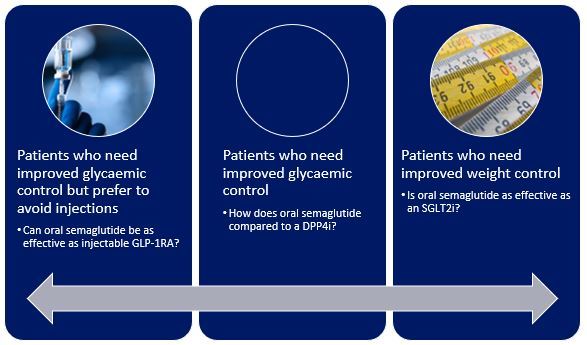Oral semaglutide use in India: Dr. Arun Kochar
M3 India Newsdesk Aug 31, 2021
Oral semaglutide, a newer formulation of GLP-1 RA recently launched in India has proven to be a great option for diabetic patients offering better HbA1c control, weight loss along with the added benefit of being easy to use. In this article, Dr. Arun Kochar reviews the drug, and highlights the benefits and dosing conditions to adhere to.
Key practice points
- Oral semaglutide seems to be a promising option for early and later stages of diabetes treatment.
- This molecule could be a revolutionary option for the management of diabetes being the most efficacious profile of oral diabetics known along with the convenience of oral administration.
- Better HbA1c control and weight reduction in comparison to comparators.
- It can be safely used in renal and hepatic impairment.
Glycaemic control is of utmost importance in Patients with Diabetes (PWD). But despite the availability of numerous anti-diabetic therapies, more than half of PWD will not achieve their glycaemic targets (Borgharkar et al. 2019; Nichols et al., 2020). CAPTURE study and many other trials proved that diabetic patients are at increased risk of cardiovascular disease. Obesity also contributes significantly to morbidity and mortality in PWD. There is an unmet need for antidiabetic therapy which will not only provide glycaemic control but also weight loss along with CV benefits.
Glucagon-like peptide-1 receptor agonist (GLP-1RA) is a class of drugs with proven cardiovascular benefits with weight loss advantage. It addresses six out of eight pathophysiologies of the ominous octets of type 2 diabetes mellitus. However, GLP-1 RA has historically been limited for widespread acceptance owing to being injectable in nature.
Recently, a newer formulation of GLP-1 RA has been launched in India. Oral semaglutide has shown its efficacy and safety in cardiovascular outcome trials and is undoubtedly one of the best anti-diabetic drugs available at present. It has been approved by US FDA in September 2019 and by DCGI in 2020. The pharmacology behind this peptide for absorption had been its unique co-formulation with 300 mg sodium N-[8-(2-hydroxy benzoyl) amino] caprylate (SNAC), which acts as an absorption enhancer. SNAC protects semaglutide from degradations in the GI tract and helps in its permeation by transcellular mechanism into the systemic circulation.
Dosage and administration
Oral semaglutide is the world’s first-in-class oral GLP-1RA and due to its once-daily oral dosage has the advantage of better patient compliance and adherence.
It is available in 3, 7, and 14 mg dosage forms and is stable at room temperature. It has to be taken empty stomach in the morning with 120 ml of water. The patient should not take anything orally for 30 minutes after taking the medicine. Up titration of the dose can be done at monthly intervals keeping in view the possible gastrointestinal side effects. It is recommended that semaglutide tablets be taken intact as SNAC plays an important role in the bioavailability of oral semaglutide.

Fig. 1: Dosing conditions for oral semaglutide
Efficacy of oral semaglutide
Efficacy and safety of oral semaglutide was tested in the comprehensive phase-3 Pioneer clinical trial programme that was designed with international recommendations and guidelines, as well as considering the clinical practice, in mind. It was tested in series of eight global and two Japanese phase-3 studies encompassing the continuum of treatment in type 2 diabetes mellitus, ranging from patients managed with diet and exercise only (drug-naïve), through to people already taking one or more, other anti-diabetic medications, those who require insulin, and in patients where cardiovascular and renal safety are concerns (Avgerinos et al., 2020; Meier et al., 2021).
Three important questions were addressed in the Pioneer trial program in deciding the therapy in patients who are already on treatment as shown in figure 2.
- Patients who need improved glycaemic control but prefer to avoid injections
- Patients who need improved glycaemic control
- Patients who need improved weight control

Fig. 2: Practical questions answered in Pioneer trial program
Figure 3 shows various trials of the Pioneer program

Fig.3 Pioneer trial program
Key takeaways from Pioneer trial program
- Oral semaglutide has shown up to a 1.5% reduction in HbA1c across pioneer trials.
- In a post-hoc analysis of Pioneer trial, it has shown HbA1c reductions of up to 2.6 % in patients with baseline HbA1c more than 9%.
- Seven out of 10 subjects achieved a glycaemic target of HbA1c <7 on oral semaglutide.
- In placebo-controlled trials (Pioneer 1,4,8), Asians had a better HbA1c reduction compared to other participants of other races
- Oral semaglutide provides weight loss of up to 5 kg in the pioneer trial programme.
- Mild-to-moderate and transient gastrointestinal events were the most common side effect.
- It can be given in CKD patients as well.
Semaglutide and CV benefits
- Oral semaglutide had shown a 21% reduction in MACE, 49% reduction in all-cause mortality, and 51% reduction in CV mortality in comparison to standard of care.
- Oral semaglutide showed similar cardiovascular safety to the standard of care, although the trial was a pre-approval CVOT and was not designed to prove superiority.
- In subcutaneous semaglutide, 26% statistically significant reduction in 3P-MACE in comparison to standard of care proves CV superiority with SC semaglutide.
- Although there is also a positive trend favouring oral semaglutide for each of the components of the primary endpoint in both the individual trials.
- SOUL study is an ongoing CVOT trial with oral semaglutide to look for CV benefits where more than 9500 patients are enrolled.
Click here to see references
Disclaimer- The views and opinions expressed in this article are those of the author's and do not necessarily reflect the official policy or position of M3 India.
The author, Dr. Arun Kochar is a Senior Interventional Cardiologist practising in Mohali.
-
Exclusive Write-ups & Webinars by KOLs
-
Daily Quiz by specialty
-
Paid Market Research Surveys
-
Case discussions, News & Journals' summaries